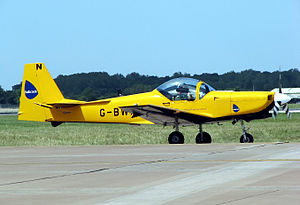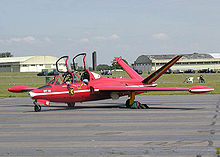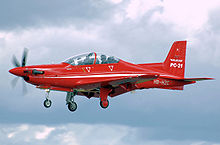- Trainer (aircraft)
-
Trainer 
Slingsby T-67 Firefly of the UK Defence Elementary Flying Training School, used for training Army and Navy pilots A trainer is a class of aircraft designed specifically to facilitate in-flight training of pilots and aircrews. The use of a dedicated trainer aircraft with additional safety features—such as tandem flight controls, forgiving flight characteristics and a simplified cockpit arrangement—allows pilots-in-training to safely advance their real-time piloting, navigation and/or warfighting skills without the danger of overextending their abilities alone in a fully featured aircraft.[citation needed]
Civilian pilots are normally trained in a light aircraft, with 2 or more seats to allow for student and instructor. The aircraft may be modified to withstand the flight conditions imposed by training flights.
Contents
Tandem or side by side
 Cockpit of the Aermacchi SF.260. Student pilot or PIC in the right seat where all primary flight instrument are.
Cockpit of the Aermacchi SF.260. Student pilot or PIC in the right seat where all primary flight instrument are.
The two seating configurations for trainer aircraft are pilot and instructor side by side or in tandem, usually with the pilot in front and the instructor behind. The side-by-side seating configuration has the advantage that pilot and instructor can see each others actions, allowing the pilot to learn from the instructor and the instructor to correct the student pilot. The tandem configuration has the advantage of being closer to the normal working environment that a fast jet pilot is likely to encounter.
It is now the norm for pilots to begin their flight training in an aircraft with side by side seating and to progress to aircraft with tandem seating. This however has not always been the case. For example, it was usual to find tandem seating in biplane basic trainers such as the Tiger Moth and the Jungmann, and the British used side by side seating in the operational conversion of some of its fast jets such as the English Electric Lightning.
Phases
 HAL HJT-36 jet trainer that will replace the HAL Kiran aircraft of the Indian Air Force, together with the HAL Tejas.
HAL HJT-36 jet trainer that will replace the HAL Kiran aircraft of the Indian Air Force, together with the HAL Tejas.
Given the expense of military pilot training, air forces typically conduct training in phases to winnow out unsuitable candidates. The cost to those airforces that do not follow a gradated training regimen is not just monetary but also in lives. For example, for many years the Indian Air Force operated without a suitable advanced training aircraft, leading to a high casualty rate as pilots moved to high performance MiG 21 aircraft without suitable assessment of their aptitude for supersonic flight.[1] In times of war the chances of victory increase with the quality of a pilot's training.
There are two main areas for instruction, flight training and operational training. In flight training a candidate seeks to develop their flying skills. In operational training the candidate learns to use his or her flying skills through simulated combat, attack and fighter techniques.
Ab initio
Typically, contemporary military pilots learn initial flying skills in a light aircraft not too dissimilar from civilian training aircraft. In this phase pilot candidates are screened for mental and physical attributes. Aircraft used for this purpose include the Slingsly Firefly, as at one time used by the USAF Academy, and the Scottish Aviation Bulldogs of the RAF. The USAF replaced the Firefly and the Enhanced Flight Screen Program (EFSP) with the Diamond DA20 and the Initial Flight Screening (IFS) program.[2] At the end of this stage pilot trainees are assessed as to where their attributes lie, as fast jet, multi-engine or rotary wing pilots. Those judged unsuitable for a pilot commission, but show other attributes may be offered the chance to qualify as navigators and weapons officers.[3]
Smaller and more financially restricted air forces may use ultra-light aircraft, gliders and motor gliders for this role.
Basic training
 Fouga Magister jet trainer of the Belgian Air Force. The Magister first flew in 1952 with deliveries beginning in 1956
Fouga Magister jet trainer of the Belgian Air Force. The Magister first flew in 1952 with deliveries beginning in 1956
After the ab-inito phase a candidate may progress to basic trainers/primary trainers. These are usually turboprop trainers like the Pilatus PC-9 and Embraer Tucano. Modern turbo-prop trainers can replicate the handling characteristics of jet aircraft as well as having sufficient performance to assess a candidate's technical ability at an aircraft controls, reaction speed and ability to anticipate events. Prior to the availability of high performance turboprops, basic training was conducted with jet aircraft such as the BAC Jet Provost, T-37 Tweet, and Fouga Magister. Those candidates who are not suitable to continue training as fast jet pilots may be offered flying commissions and train to fly multi-engined aircraft e.g. transport and tanker aircraft.[3]
Advanced training
Those that progress to training for fast jet flying will then progress to an advanced trainer, typically capable of high subsonic speeds, high-energy manoeuvers, and equipped with systems that simulate modern weapons and surveillance.[4] Examples of such jet trainer aircraft include the T-38 Talon (actually capable of supersonic speeds), the BAE Hawk, the Dassault/Dornier Alpha Jet and the Aero L-39.
Effective combat aircraft are a function now of electronics as much as if not more so than the aerobatic ability or speed of an aircraft. It is at this stage that a pilot begins to learn to operate radar systems and electronics. Modern advanced trainers feature programmable multi-function displays which can be programmed to simulate different electronic systems and scenarios. Most advanced trainers do not have radar systems of their own, but onboard systems can be programmed to simulate radar contacts. With datalinks and GPS virtual radar systems can be created with similarly equipped aircraft relaying to each other their positions in real time and onboard computers creating a "Radar display" based on this information.[5] The aim of programmable displays is to speed pilot training by replicating as far as possible the systems a pilot will find in an operational aircraft.
Lead-in fighter training
Lead-in fighter training (LIFT) utilises advanced jet trainer aircraft with avionics and stores-management capability that emulate operational fighter planes, to provide efficient training in combat scenarios with reduced training cost compared to moving straight to operational conversion.[6][7][8] The on-board avionics system may be linked to ground-based systems, and together they can simulate situations such as infrared or radar guided missile, interceptors, air-to-air and surface-to-air missiles, anti-aircraft batteries, radars, chaff and flare countermeasures and collision warnings, in low or dense electronic warfare environments. Systems may also be able to re-enact true-to-life combat situations.[9]
Operational conversion
 A US Marine Corps TA-4F, a two seat combat capable training version of the normally single seat A-4 Skyhawk.
A US Marine Corps TA-4F, a two seat combat capable training version of the normally single seat A-4 Skyhawk.
Most military ground-attack or interceptor aircraft have two-seat trainer versions. These are combat capable operational conversion aircraft types to provide "on the job training" to pilots who have graduated to this level, and are usually available with little conversion in times of emergency to a reconnaissance or combat role. There would be little point in having operational training aircraft that do not replicate fully the abilities of the operational aircraft, and most operational conversion aircraft retain the full functionality of the operational version with slight degradations to performance due to increased weight and drag, and possibly reduced range due to a reduced internal fuel load.
In some two seat fighter aircraft such as the Tornado, the OCU aircraft can be created by duplicating flight controls in the rear cockpit. In normally single seat aircraft a second cockpit can be built behind the original cockpit (e.g. the TA-4S variant of the A-4SU Super Skyhawk) or the cockpit can be extended to place the instructor in a second seat behind the pilot. Once they have qualified in being able to fly a specific type of aircraft and have learned to use these aircraft to best effect, pilots will continue with regular training exercises to maintain qualifications on that aircraft and to improve their skills, for example the USAFs Red Flag exercises. Deployments of small flights of aircraft together with support staff and equipment to exercises conducted by other nations can be used to develop fighting skills and interservice and inter unit competitions in bombing and gunnery between units can also be used to develop those skills.
The two seat aircraft may itself become the basis of an operational aircraft, the second seat being used to create a weapons officer/navigators station in aircraft with originally only a pilot, for example the F-15E Strike Eagle is a development of the F-15D which is a two seat training version of the F-15 Eagle.
In some air forces that have a mix of high and low performance aircraft, pilots can be first be assigned to aircraft with a lower level of performance before moving on to the most demanding aircraft. For example in the Italian Air Force a pilot may begin his service career on the AMX attack aircraft, and as his experience grows progress to more capable aircraft such as the Tornado IDS. Other air forces, such as Canada, do not do this and assign first-tour pilots to aircraft such as the CF-18 Hornet.
Multi-engine trainers
Those pilots who are destined to fly transports, tankers and other multi-engine aircraft begin with small multi-engine aircraft such as the T-44A Pegasus variant of the Beechcraft King Air. Once they have mastered this they may begin to fly in the right hand seat of an operational type. Some airforces will seek to use a restricted number of multi-engined aircraft, with the derivatives of a basic aircraft filling different roles so that a pilot qualified on one of its types can easily convert to others in the same family. For example the Boeing 707 was a popular airliner for conversion to tanker, transport and ELINT variants by numerous air forces.
A minority of military training aircraft, such as the Vickers Varsity, Hawker Siddeley Dominie or Boeing T-43 were developed from transport designs to train navigators and other rear crews operators. As these navigational trainees are normally learning how to navigate using instruments, they can be seated at consoles within the aircraft cabin and do not require a direct view of the landscape over which the aircraft is flying. The operators of airborne weapons or radar-related systems can be similarly trained, either in training aircraft or in an operational aircraft during training flights.
Aerobatic display teams
Some jet trainers, such as the Aermacchi MB-326, Casa C-101, Folland Gnat, Fouga Magister and British Aerospace Hawk, are used by national formation aerobatic teams. Early jet aerobatic teams tended to use combat types such as the Hawker Hunter, English Electric Lightning, and North American F-100 Super Sabre. As air forces' combat fleets were scaled-down, it made sense for most national display teams to change to lighter training types. A few modifications may be needed to enable coloured smoke to be emitted during displays, but essentially these airframes can still perform their pilot training function.
Combat use of trainers
In smaller air forces basic trainers, in addition to being used for training, are used as counter insurgency, airborne FAC and in the light strike/COIN role.
Most advanced trainers are capable of carrying and delivering war loads. However most of these aircraft do not have the counter measures and sensors to survive alone in a modern high intensity war fighting scenario, for example being vulnerable to MANPADs. However they may still have a war fighting role in low intensity theatres, and if they operate in conjunction with more capable aircraft.
Historically many jet trainers were marketed with specialised attack variants e.g. the BAC Jet Provost/BAC Strikemaster and the Cessna T-37 Tweet/A-37 Dragonfly. Especially against opponents operating without a fighter screen or an effective anti-aircraft capability, such trainer derived attack aircraft could perform adequately. For example Impala aircraft derived from the Aermacchi MB-326 trainer formed the main strike strength of the South African Air Force in its Bush war,[10] and aircraft such as the Hongdu JL-8 are being acquired for the attack role in low intensity theatres.[11][12]
Despite their vulnerability even small numbers of combat-equipped trainer aircraft in low-intensity theatres can have a disproportionate effect due to the surprise and shock of coming under air attack, especially when the attacked side believes itself to have a monopoly on air power.[13] Forces that have used light trainer aircraft to great effect include the Biafran use of MFI-9s[14] and the Liberation Tigers of Tamil Eelam use of covertly acquired light aircraft.[15]
In high-intensity conflicts, advanced trainer type aircraft can have a military utility if they operate within a framework of other assets. For example the German and French Dassault/Dornier Alpha Jets had anti-shipping and light strike roles operating under an air umbrella provided by other aircraft, while the RAF planned to use pairs of gun- and AIM-9 Sidewinder-armed Hawk trainers in the point defence role. Each pair of Hawks was to be teamed with a Phantom FGR.2, in effect using the Phantoms as an Airborne Early Warning and Control system. Although never tested it was believed that the Hawk, combined with AIM-9L and flown by some of the best pilots in the RAF including those from the Red Arrows, would have made a viable air defence fighter.[16]
The future
As the capabilities of front line aircraft have increased this has been reflected in increasingly sophisticated advanced trainers. As the costs of developing new aircraft have risen in real terms, it has become more likely that fewer aircraft will be designed specifically for the training role. The advanced trainer was often seen as a stepping stone by most nations in developing a fast jet design and manufacturing capability. With increasing costs, even major air forces will have difficulty reaching the economies of scale to justify development of new advanced trainers. Nations will be required to continue to push the modernisation of existing aircraft (some such as the Hawk dating from the 1970s)[17] or co-operate in the development and procurement of advanced training aircraft. Furthermore they must better utilise funding available by developing aircraft with an enhanced combat capability by producing operational single seat variants, and better utilise aircraft on inventory incorporating operational systems either within the aircraft or as external pods.[18]
The trend of programmable electronic systems and datalinks is likely to continue with the possibility that ground based radar systems and processing systems will allow advanced training aircraft to function as if they truly had onboard radar systems, with the cockpit closely replicating the look and feel of an air forces more capable aircraft for maximum familiarity.[19] Programmable engine management and fly-by-wire flight control systems will allow an aircraft to mimic the flight characteristics of frontline aircraft[20] with actual performance being restricted to a pilot's level of ability, with more power and greater agility becoming available as a pilot's skill improves.
Training is now also carried out on ground-based simulators.[21]
Historical
Classic training types were the De Havilland Tiger Moth, the North American Texan (Harvard in many countries) and the De Havilland Chipmunk.
References
- ^ Sharma, Ravi (June 23 - July 06, 2001). "On a crash course". Frontline (magazine) (The Hindu Group). http://www.hinduonnet.com/fline/fl1813/18130650.htm. Retrieved 2008-06-30.
- ^ WantsCheck.Com Military Flight Planning
- ^ a b Training
- ^ Phases of Military Pilot Training
- ^ IAR-99C Soim Lead In Fighter Jet Trainer Aircraft, Romania
- ^ Lead-in fighter trainers - newcomers take on the old guard
- ^ IAR 99
- ^ 5367 - Lead-In Fighter Project
- ^ Elbit ACTS
- ^ The Border War, SAAF museum
- ^ Chang, Andrei (September 17, 2008). "China exports attack craft to Sudan". United Press International. http://www.upiasia.com/Security/2008/09/16/china_exports_attack_craft_to_sudan/4697/. Retrieved 14 November 2008.
- ^ Dilley, Ryan (29 May 2002). "The 'trainer' jet the UK loves to hawk". bbc.co.uk (BBC). http://news.bbc.co.uk/1/hi/uk/2012743.stm. Retrieved 14 November 2008.
- ^ "Sri Lankan rebels launch air raid". bbc.co.uk (BBC). 26 March 2007. http://news.bbc.co.uk/1/hi/programmes/letter_from_america/6494121.stm?ls. Retrieved 14 November 2008.
- ^ "How to Build an Instant Air Force". Time (magazine) (Time Inc.). June 6, 1969. http://www.time.com/time/magazine/article/0,9171,941667,00.html. Retrieved 14 November 2008.
- ^ Buerk, Roland (26 March 2007). "Tamil Tigers unveil latest tactic". bbc.co.uk (BBC). http://news.bbc.co.uk/1/hi/world/south_asia/6496381.stm. Retrieved 14 November 2008.
- ^ Thetford, Owen (1995 edition). Aircraft of the Royal Air Force since 1918. Putnam. pp. 108–109. ISBN 0-5177-865-8.
- ^ Lead-In Fighter Project
- ^ M-346 Advanced fighter trainer
- ^ MAKO advanced trainer and light attack aircraft
- ^ Yak 130 Combat trainer
- ^ "New simulators, online courses change face of flight training"
Military aircraft types by roles Military aircraft roles AEW · Bomber · EW · Fighter · Ground-attack · Maritime patrol · Multi-role · Reconnaissance · Surveillance · Tanker · Trainer · Transport
Military aircraft types Military balloon · Military glider · Military helicopter · Missile · UAV
Lists relating to aviation General Aircraft (manufacturers) · Aircraft engines (manufacturers) · Airlines (defunct) · Airports · Civil authorities · Museums · Registration prefixes · Rotorcraft (manufacturers) · TimelineMilitary Accidents/incidents Records Categories:- Military trainer aircraft
Wikimedia Foundation. 2010.







